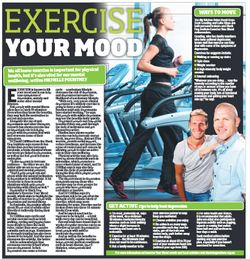Spring is the perfect time of year to exercise…your mood. There is so much evidence from Australia and overseas about the direct links between exercise and improved mental health. We’re here to help!
We spoke to our friends at the Black Dog Institute about their work and research, and asked them for some information and advice we could pass on to you. Here’s the great information they supplied.
First, a quick video…
What’s the research say?
Research suggests that regular exercise may increase the level of brain serotonin, a neurotransmitter involved in regulating mood, sleep, libido, appetite and other functions. Problems in the serotonin pathways of the brain have been linked to depression.
Exercise can also increase the level of endorphins in the brain which have ‘mood-lifting’ properties.
Before you go on, ever wondered what ‘depression’ actually means? Find out here.
OK, so how does exercise actually help?
Regular exercise may alleviate symptoms of depression by:
- Increasing energy levels
- Improving sleep
- Distracting from worries and rumination
- Providing social support and reducing loneliness, if exercise is done with other people
- Increasing a sense of control and self-esteem, by allowing people to take an active role in their own well-being

Click to download and read this article on “Exercise Your Mood Month”
What evidence is there about the link between exercise and mood?
Regular exercise can be an effective way to relieve some forms of depression and is often a neglected strategy in the management of depression:
- Numerous studies have shown that people who exercise regularly experience fewer symptoms of depression and anxiety than those who do not exercise regularly.
- Several trials have shown that regular exercise of moderate intensity can be an effective adjunctive treatment by itself for both melancholic and non-melancholic depression.
- Two trials have found that 16 weeks of regular exercise is equally effective as antidepressant medication in the treatment of mild to moderate depression
- Research also suggests that exercise can further assist depression in individuals with depression who have only partially responded to an anti-depressant medication
- Both aerobic exercise (e.g. brisk walking, cycling or jogging) and resistance or strength training (e.g. weight-lifting) have been found to be helpful in treating depression
In addition to being helpful for managing depression, regular exercise has numerous physical health benefits. These benefits include prevention of numerous (including life threatening) medical conditions such as heart disease, type 2 diabetes, osteoporosis, strokes and certain types of cancers.
How much exercise do I need?
The National Physical Activity Guidelines for Australians recommend:
- A minimum of 30 minutes of moderate intensity exercise on most, preferably all, days of the week; An example of ‘moderate intensity’ exercise is brisk walking where a slight increase in breathing and heart rate is noticeable
- Exercising for at least 10 minutes at a time – the 30 minutes total does not need to be continuous; Short sessions of different activities can be combined to make up a total of 30 minutes exercise or more each day
- Being active in as many ways as possible each day (e.g. using the stairs instead of a lift)
At least one study has shown that exercising at around the optimal level for 12 weeks can significantly reduce symptoms of depression amongst people who are inactive and experiencing non-melancholic depression.
For people who are very inactive, health benefits can be gained by becoming slightly more active. A little activity is better than none at all and more is better than a little.
For extra health and fitness, it is recommended that adults (who are able) should also participate in vigorous activity that makes them ‘huff and puff’ (e.g. jogging, squash, rowing).
For best results, vigorous exercise should be done for 30 minutes or more on three to four days per week (on top of moderate exercise).
Exercise in Centennial Parklands – we’re here all year round for you and your health
Thanks to our friends at the Black Dog Institute for the information. You can find out more about them via this great short video, and there’s even more on their website, or you can join them on Facebook or Twitter.
There are so many ways to exercise your mood in Centennial Parklands:
…and much, much more. Visit our website, subscribe to an eNewsletter, like us on Facebook, follow us on Twitter or just come visit us.
Get out into the Parklands and exercise your mood!